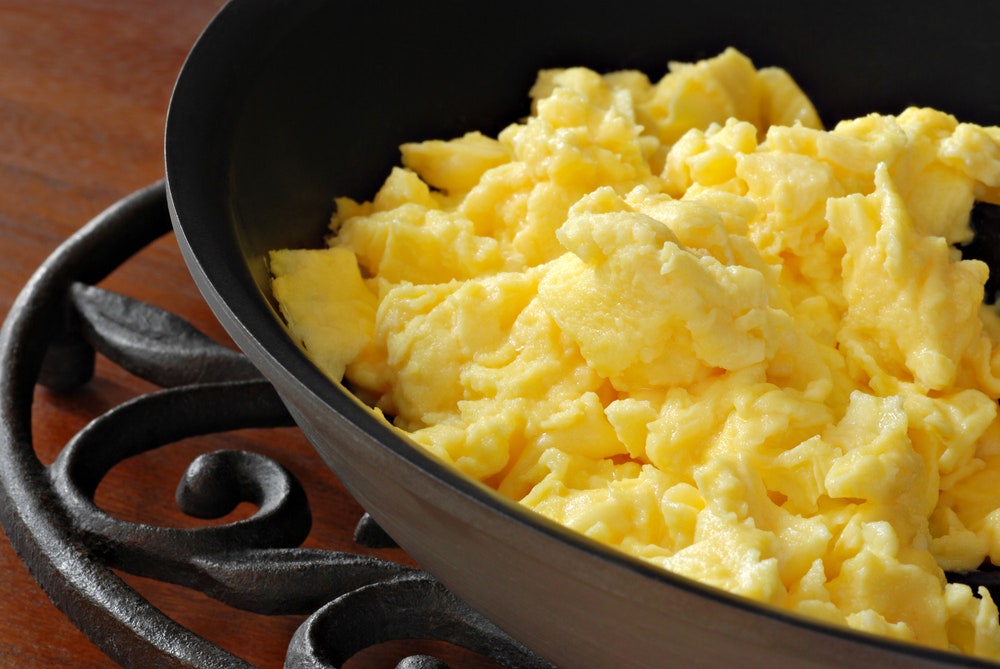Best Scrambled Eggs
Everyone knows how to cook scrambled eggs. It’s probably the first thing you really learn to cook for yourself (making the peanut butter sandwiches doesn’t really count as cooking). So why write an article on scrambling eggs? Because we’re sophisticated egg consumers, and we want more from a scrambled egg than a sad, floppy set of curds or overdone, dry cake of egg.
Things we want in a good dish of scrambled eggs:
- moist
- puffy
- tender
- 1/4 tsp. salt
- pepper to taste
- 8 eggs
- 1 tbsp butter (or bacon grease)
- 1/4 c. heavy cream
- 8 in. skillet
- spatula
- Using a fork, beat the eggs, salt, and cream until combined well and the mixture is a pure yellow with no streaks. Do not overbeat. You’re done when you can lift the fork out of the bowl and the egg mixture leaves the fork in a thin, homogenous stream.
- Melt butter in the 8″ skillet over medium heat. Don’t let the butter brown. Swirl the pan to coat the bottom with the melted butter.
- Add the egg mixture. Using a spatula, scrape firmly along the bottom and sides of the skillet constantly until the eggs begin to clump and the spatula leave a trail behind it. (I like to scrape across the diameter of the pan in a counterclockwise motion. For instance, draw the spatula from 12 to 6, then pick it up and draw from 1 to 7, etc.)
- Reduce heat to low and gently fold the eggs on top of each other, creating layers until they clump and are barely wet. This will take 30-60 seconds.
- Transfer to a bowl or plate, season with pepper to taste, and serve.
- Don’t use iodized salt in this. You will be able to taste it.
- If you like, substitute truffle salt in place of the regular salt for a treat.
- Cook’s Illustrated All Time Best Recipes(2020).
The overall goal of a perfect set of scrambled eggs is to control the unfolding and bonding of the egg proteins in just the right way. We’ll go through the different aspects of obtaining these results, then give the recipe. It’s really more of a technique than a true “recipe”, as it were.
Beat the eggs first, or crack in the pan?
Definitely beat the eggs first, but gently, using a fork rather than a whisk. Overbeating the eggs will make a tough scramble. Beating does destroy the structure of the egg proteins, which we want, but overbeating will unfold the proteins too much. Once this happens, they’ll bond very tightly to each other when the eggs hit the heat, resulting in a tough set of eggs.
Add salt to your raw eggs, not at the end.
Salt dissolves egg proteins so they cannot bond as tightly when cooked. This helps our eggs stay tender when heat is added.
Bring in dairy
You’ll likely find recipes for scrambled egg that call for using a dash of milk, cream, or half-and-half. The dairy added provides water and fat, which tenderize the eggs. I use heavy cream, because it provides a hearty richness to the scrambled eggs. Milk will yield a fluffier curd, but I found the flavor personally a bit weak.
Room temperature or cold eggs?
When baking a cake, the temperature of the egg matters quite a bit, but here you’ll find it makes no difference whether you begin with room temperature eggs or eggs straight from the fridge.
How to handle the heat
Low heat produces tender curds, and high heat creates steam that puffs them up. How do we reconcile this? By using both.
Use medium heat at first, scraping the bottom and sides to form large curds and prevent overcooking. When the spatula can be drawn through the pan and no raw egg residue rushes in the fill the gap, it’s time to drop the heat to low and start folding. The folding will finish cooking the eggs and help trap steam to maintain the fluffiness.
The size of the pan matters
When folding, we want a thicker layer of egg to help trap steam. Using a pan that’s too large will not allow this. I use exclusively an 8″ skillet to cook up to 7-8 eggs. If you’re the type who needs to scramble a dozen or more at a time, you can try a 10″ or 12″ skillet, but increase the size of the pan slowly. I personally haven’t scaled my batch sizes up enough to give an exact number of eggs when it’s acceptable to switch to a larger pan.












